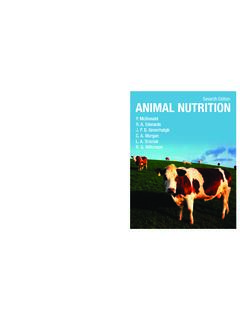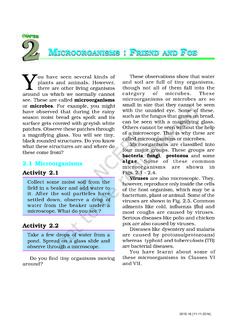Transcription of Livestock Impacts on the Environment - United Poultry …
1 Livestock Impacts on the Environment Vegan Shampoo The Best Cruelty Free Shampoo List Vegan Toothpaste The Best Cruelty Free Toothpaste List Vegan Memes Funny Vegan Pictures The Livestock sector is undergoing a complex process oftechnical and geographical changeLivestock and the rural poorDespite its wide-rangingenvironmental Impacts , Livestock isnot a major force in the globaleconomy, generating just under of total GDP. But thelivestock sector is socially andpolitically very significant in developing countries: itprovides food and income for one billion of the world'spoor, especially in dry areas, where Livestock are oftenthe only source of livelihoods. "Since livestockproduction is an expression of the poverty of peoplewho have no other options," FAO says, "the hugenumber of people involved in Livestock for lack ofalternatives, particularly in Africa and Asia, is a majorconsideration for policy makers."Spotlight / 2006 Livestock Impacts on theenvironmentThe challenge is to reconcile twoconflicting demands: for animalfood products and new report from FAO says livestockproduction is one of the major causes of theworld's most pressing environmentalproblems, including global warming, landdegradation, air and water pollution, andloss of biodiversity.
2 Using a methodologythat considers the entire commodity chain,it estimates that Livestock are responsiblefor 18 percent of greenhouse gasemissions, a bigger share than that oftransport. However, the report says, thelivestock sector's potential contribution tosolving environmental problems is equallylarge, and major improvements could beachieved at reasonable on the most recent data available, Livestock 's long shadow takes into account the Livestock sector's directimpacts, plus the environmental effects of related land use changes and production of the feed crops animalsconsume. It finds that expanding population and incomes worldwide, along with changing food preferences, arestimulating a rapid increase in demand for meat, milk and eggs, while globalization is boosting trade in both inputsand the process, the Livestock sector is undergoing acomplex process of technical and geographical is shifting from the countryside to urban andperi-urban areas, and towards sources of animal feed,whether feed crop areas or transport and trade hubs wherefeed is distributed.
3 There is also a shift in species, withaccelerating growth in production of pigs and Poultry (mostly in industrial units) and a slow-down in that ofcattle, sheep and goats, which are often raisedextensively. Today, an estimated 80 percent of growth inthe Livestock sector comes from industrial productionsystems. Owing to those shifts, the report says, livestockare entering into direct competition for scarce land, waterand other natural , greenhouse gases. The Livestock sectoris by far the single largest anthropogenic user of occupies 26 percent of the Earth's terrestrialsurface, while feed crop production requires about a thirdof all arable land. Expansion of grazing land for Livestock isa key factor in deforestation, especially in Latin America: some 70 percent of previously forested land in theAmazon is used as pasture, and feed crops cover a large part of the reminder. About 70 percent of all grazing landin dry areas is considered degraded, mostly because of overgrazing, compaction and erosion attributable tolivestock the same time, the Livestock sector has assumed an often unrecognized role in global warming.
4 Using amethodology that considered the entire commodity chain (see box below), FAO estimated that Livestock areNew measurement for greenhousegasesScientists usually tie their estimates of the greenhouse gas emissionsresponsible for global warming to sources such as land use changes,agriculture (including Livestock ) and transportation. The authors ofLivestock s long shadow took a different approach, aggregatingemissions throughout the Livestock commodity chain - from feedproduction (which includes chemical fertilizer production, deforestationfor pasture and feed crops, and pasture degradation), through animalproduction (including enteric fermentation and nitrous oxide emissionsfrom manure) to the carbon dioxide emitted during processing andtransportation of animal on many frontsThe FAO report recommends a range of measures tomitigate Livestock 's threats to the Environment : Land degradation: Restore damaged land throughsoil conservation, silvopastoralism, better managementof grazing systems and protection of sensitive areas.
5 Greenhouse gas emissions: Sustainableintensification of Livestock and feed crop production toreduce carbon dioxide emissions from deforestation andpasture degradation, improved animal nutrition andmanure management to cut methane and nitrogenemissions. Water pollution: Better management of animalwaste in industrial production units, better diets toimprove nutrient absorption, improved manuremanagement and better use of processed manure oncroplands. Biodiversity loss: As well as implementing themeasures above, improve protection of wild areas,maintain connectivity among protected areas, andintegrate Livestock production and producers intolandscape for 18 percent of greenhouse gas emissions, a bigger share than that of transport. It accounts for ninepercent of anthropogenic carbon dioxide emissions, most of it due to expansion of pastures and arable land forfeed crops. It generates even bigger shares of emissions of other gases with greater potential to warm theatmosphere: as much as 37 percent of anthropogenic methane, mostly from enteric fermentation by ruminants,and 65 percent of anthropogenic nitrous oxide, mostly from production also Impacts heavilythe world's water supply, accounting formore than 8 percent of global human wateruse, mainly for the irrigation of feed suggests it is the largest sectoralsource of water pollutants, principallyanimal wastes, antibiotics, hormones,chemicals from tanneries, fertilizers andpesticides used for feed crops, andsediments from eroded pastures.
6 Whileglobal figures are unavailable, it isestimated that in the USA Livestock andfeed crop agriculture are responsible for 37percent of pesticide use, 50 percent ofantibiotic use, and a third of the nitrogenand phosphorus loads in freshwaterresources. The sector also generates almosttwo-thirds of anthropogenic ammonia,which contributes significantly to acid rainand acidification of sheer quantity of animals being raised for human consumption also poses a threat of the Earth's account for about 20 percent of the total terrestrial animal biomass, and the land area they now occupywas once habitat for wildlife. In 306 of the 825 terrestrial eco-regions identified by the Worldwide Fund for Nature, Livestock are identified as "a current threat", while 23 of Conservation International's 35 "global hotspots forbiodiversity" - characterized by serious levels of habitat loss - are affected by Livestock demands. FAO says "the future of the Livestock - Environment interface will be shaped by how we resolve thebalance of two demands: for animal food products on one side and for environmental services on the other".
7 Sincethe natural resource base is finite, the huge expansion of the Livestock sector required to meet expanding demandmust be accomplished while substantially reducing its environmental efficiency in use of resources will be "the key to retracting Livestock 's long shadow". Although a host ofeffective technical options - for resource management, crop and Livestock production, and post harvest reductionof losses - are available (see box below), current prices of land, water and feed resources used for livestockproduction do not reflect true scarcities, creating distortions that provide no incentive for efficient resource use."This leads to the overuse of the resources and to major inefficiencies in the production process," FAO says."Future policies to protect the Environment will therefore have to introduce adequate market pricing for the maininputs."In particular, water is grossly under-priced in mostcountries, and development of water markets and varioustypes of cost recovery will be needed to correct thesituation.
8 In the case of land, suggested instrumentsinclude grazing fees, and better institutional arrangementsfor controlled and equitable access. The removal oflivestock production subsidies is also likely to improvetechnical efficiency - in New Zealand, a drastic reduction inagricultural subsidies during the 1980s helped create oneof the world's most efficient and environmentally friendlyruminant Livestock of price distortions at input and product level willenhance natural resource use, but may often not besufficient. Livestock 's long shadow says environmentalexternalities, both negative and positive, need to beexplicitly factored into the policy framework. Livestockholders who provide environmental services need to becompensated, either by the immediate beneficiary (such asdownstream users enjoying improved water quantity andquality) or by the general public. Services that could berewarded include land management or land uses thatrestore biodiversity, and pasture management thatprovides for carbon sequestration.
9 Compensation schemesalso need to be developed between water and electricityproviders and graziers who adopt grasslands managementstrategies that reduce sedimentation of water , Livestock holders who emit waste into waterways or release ammonia into the atmosphere should pay forthe damage. Applying the "polluter pays" principle should not present insurmountable problems for offenders,given the burgeoning demand for Livestock pressure. Finally, FAO says, the Livestock sector is usually driven by diverse policy objectives, anddecision-makers find it difficult to address economic, social, health and environmental issues at the same fact that so many people depend on Livestock for their livelihoods limits the policy options available, and leadsto difficult and politically sensitive , communication and education will play critical roles in enhancing a "willingness to act". With theirstrong and growing influence, consumers are likely to be the main source of commercial and political pressure "topush the Livestock sector into more sustainable forms", Livestock 's long shadow says.
10 Already, growing awarenessof threats to the Environment is translating into rising demand for environmental services: "This demand willbroaden from immediate concerns - such as reducing the nuisance of flies and odours - to intermediate demandsfor clean air and water, then to the broader, longer-term environmental concerns, including climate change andloss of biodiversity".Back to the countryside?Intensive animal production systems produce high levels ofnitrogen and phosphorus wastes and concentrateddischarges of toxic materials. Yet those systems are oftenlocated in areas where effective waste management is moredifficult. The regional distribution of intensive systems isusually determined not by environmental concerns but byease of access to input and product markets, and relativecosts of land and labour. In developing countries, industrialunits are often concentrated in peri-urban environmentsbecause of infrastructure constraints. "Environmental problems created by industrialproduction systems derive not from their large scale, northeir production intensity, but rather from theirgeographical location and concentration," FAO says.


